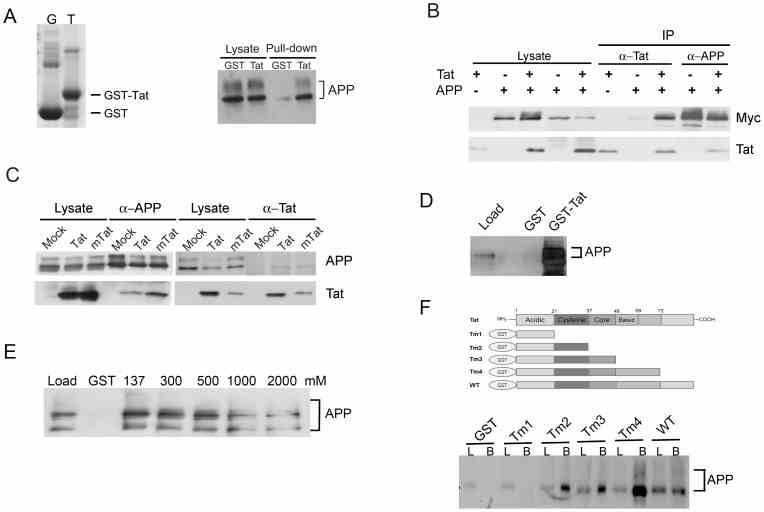Recombinant Human Amyloid Beta (A4) Precursor Protein, His-tagged
| Cat.No. : | APP-051H |
| Product Overview : | Recombinant humanAPP protein,fused to His-tag at N-terminus, was expressed in E. coli andpurified by using conventional chromatography. |
- Specification
- Gene Information
- Related Products
- Citation
- Download
| Species : | Human | ||
| Source : | E.coli | ||
| Tag : | His | ||
| Description : | APP iscleaved by secretases to form a number of peptides. Some of these peptidesare secreted and can bind to the acetyltransferase complex APBB1/TIP60 topromote transcriptional activation, while others form the protein basis of theamyloid plaques found in the brains of patients with Alzheimer disease.Mutations in this gene have been implicated in autosomal dominant Alzheimerdisease and cerebroarterial amyloidosis (cerebral amyloidangiopathy). | ||
| Form : | Liquid. 20mMTris-HCl buffer (pH8.0) containing 20% glycerol, 0.1M NaCl, 1mM DTT. | ||
| Molecular Weight : | 34.7 kDa (308confirmed by MALDI-TOF | ||
| Purity : | > 85% by SDS-PAGE | ||
| Concentration : | 1 mg/ml(determined by Bradford assay) | ||
| Sequences of aminoacids : | MRGSHHHHHHGMASMTGGQQ MGRDLYDDDD KDRWGSLEVP TDGNAGLLAE PQIAMFCGRL NMHMNVQNGKWDSDPSGTKT CIDTKEGILQ YCQEVYPELQ ITNVVEANQP VTIQNWCKRG RKQCKTHPHF VIPYRCLVGEFVSDALLVPD KCKFLHQERM DVCETHLHWH TVAKETCSEK STNLHDYGML LPCGIDKFRG VEFVCCPLAEESDNVDSADA EEDDSDVWWG GADTDYADGS EDKVVEVAEE EEVAEVEEEE ADDDEDDEDG DEVEEEAEEPYEEATERTTS IATTTTTTTE SVEEVVRE | ||
| Storage : | Can bestored at +4°C short term (1-2 weeks). For long term storage, aliquot andstore at -20°C or -70°C. Avoid repeated freezing and thawing cycles. | ||
| OfficialSymbol : | APP | ||
| nullValue_other : |
|
| Gene Name | APP amyloid beta (A4) precursorprotein [ Homo sapiens ] |
| Synonyms | APP; amyloid beta (A4) precursor protein;AAA; AD1; PN2; ABPP; APPI; CVAP; ABETA; CTFgamma; amyloid beta A4 protein;PN-II; preA4; protease nexin-II; OTTHUMP00000096095; OTTHUMP00000096096;OTTHUMP00000096097; OTTHUMP00000096098; OTTHUMP00000225525; peptidasenexin-II; beta-amyloid peptide; alzheimer disease amyloid protein; cerebralvascular amyloid peptide; Alzheimer disease; human mRNA for amyloid A4precursor of Alzheimer"s disease; A4 |
| Gene ID | 351 |
| mRNA Refseq | NM_000484 |
| Protein Refseq | NP_000475 |
| MIM | 104760 |
| UniProt ID | P05067 |
| Chromosome Location | 21q21.2 |
| ◆ Recombinant Proteins | ||
| RFL-31760TF | Recombinant Full Length Takifugu Rubripes Amyloid Beta A4 Protein(App) Protein, His-Tagged | +Inquiry |
| APP-643M | Recombinant Mouse APP Protein, His (Fc)-Avi-tagged | +Inquiry |
| APP-27315TH | Recombinant Human APP | +Inquiry |
| APP-1850H | Recombinant Human APP protein, GST-tagged | +Inquiry |
| APP-3850H | Recombinant Human APP, His & GST-tagged | +Inquiry |
| ◆ Cell & Tissue Lysates | ||
| APP-045HKCL | Human APP Knockdown Cell Lysate | +Inquiry |
| APP-3087HCL | Recombinant Human APP cell lysate | +Inquiry |
HIV-1 Tat Interacts with and Regulates the Localization and Processing of Amyloid Precursor Protein
Journal: PLoS ONE PubMed ID: 24312169 Data: 2022/11/28
Authors: Jiyoung Kim, Jee-Hyun Yoon, Ashok Chauhan
Article Snippet:Beads were washed three times with PBS, bound proteins were eluted by boiling in SDS-PAGE buffer and analyzed by 8% SDS-PAGE followed by western blotting with anti-APP (22C11) antibody.Beads were washed three times with PBS, bound proteins were eluted by boiling in SDS-PAGE buffer and analyzed by 8% SDS-PAGE followed by western blotting with anti-APP (22C11) antibody.. Purified recombinant APP (cat. no APP-526H, Creative BioMart, NY, USA) was resuspended in PBS supplemented with 1% NP-40 to yield a final concentration of 1 ng/μl, and 500 μl was incubated with GST- or GST-Tat-coated beads for 3 hours at 4°C.. The beads were washed three times with PBS supplemented with 1% NP-40.The beads were washed three times with PBS supplemented with 1% NP-40.

( A ) GST and GST-Tat
Not For Human Consumption!
Inquiry
- Reviews (0)
- Q&As (0)
Ask a Question for All APP Products
Required fields are marked with *
My Review for All APP Products
Required fields are marked with *



